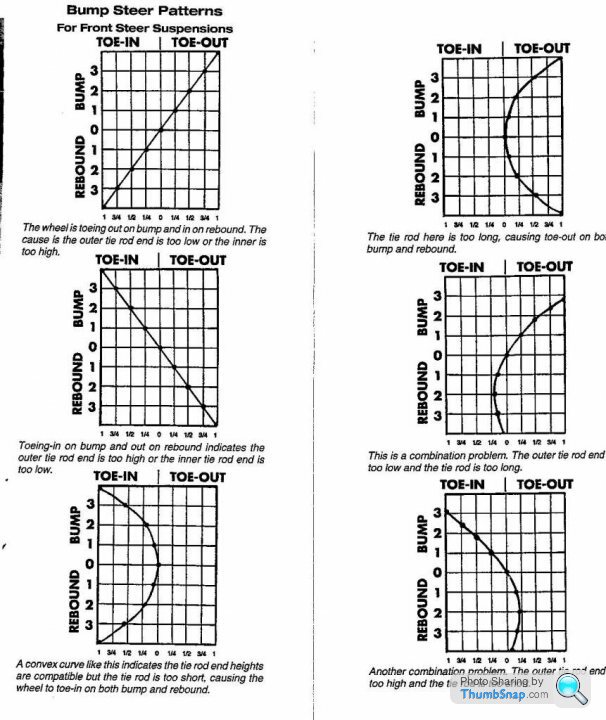Tuscan front suspension facts and experiment
Discussion
After looking at many posts on the subject of bump steer issues with the early Tuscan and having experienced first hand the effect of adding spaces to my prevous '04 Tuscan, I am now aware of the small changes that can have a massive effect on the way a car feels and steers.
For anyone wanting to know more about suspension design, I would reccoment reading "The sports car and Kit car suspension and brakes high performance manual". Its hardcore reading and takes a while to sink in. I'd also reccomend getting your hands on a remote controlled buggy so that you can play with the suspension and see the relationships and effects of different settings.
I am in the throws of rebuilding my Tuscan from the ground up:
http://www.pistonheads.com/gassing/topic.asp?h=0&a...
and the latest discussion has moved onto the suspension and whether I should change the design to the later configuration.
The research I have done shows that in march 2001 the design of the front suspension changed in the following way:
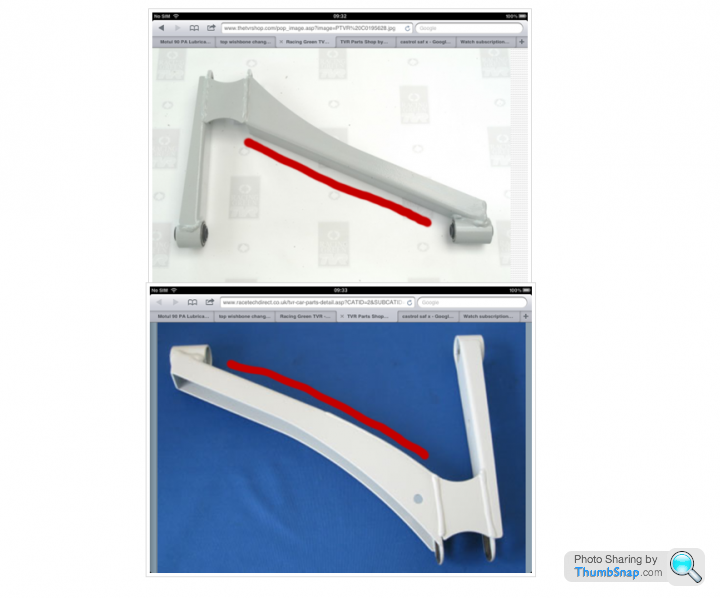
Bump steer is often refered to as "The problem with the early cars". From my dealings and involvement with the SP Wheel Spacers (I was the first person to test it), I understand that tyre wall height has an effect on the scrub radius and by either increasing the tyre wall or increasing your offset with a spacer, it is possible to alter the scrub radius.
From what I have read, the scrub radius needs to pass through the contact patch of the tyre and depending on whether it passes inboard or outboard of the centre line of the wheel, it can have an effect of pulling the wheel either outboard or inboard.
Acknowledging the above, if in addition to the scrub radius, there is an effect of bump steer that will cause the wheels to point outwards (positive toe) or inwards (negative toe), the effect can be significantly amplified.
Therefore, I set out to understand suspensions characteristics on MY CAR (Jan 2000). I can only comment on my car due to the aformentioned variables.
I set up my geometry to the following default factory settings:
I used this experimental setup/technique to measure bump steer: http://youtu.be/LO07qmJ9zkk
My videos show the standard setup, and with 4mm added beneath the steering rack.
http://youtu.be/3QKvdZWyV_I
http://youtu.be/_Yt0JcNhxOA
From what I understand, the thing to look out for is not to have too much bump oversteer. When there is compression of the outer wheel's suspension in a corner, any bump oversteer (additinal toe in) of the outer wheel, causes the wheel to point into the corner more than you want to/have dialed in with the steering wheel. If this happens you'll be turning in too much, so you'lll have to take off steering lock, which reduces the load on the outer wheel, (reducing the compression), which in turn takes off the bump oversteer, which then means you're not turning in enough, so you have to turn into the corner more...... This leads to an unstable cornering car that for want of a better word, 'weaves' through the corner.
The ideal scenario, is to not have any bump oversteer on the outside wheel, so that the amount you steer in, is the amount you get. Having said that, having bump understeer on the inside wheel, (which is drooping/lower than ride height due to body roll), means the inside wheel turns in more to the corner, which helps/can be beneficial up to a point.
I also tried the experiment with 2mm spacer. This seemed to give the best compromise. The suspension's toe stayed within 0.2mm thoughout 85% of the total travel of the suspension.
Here are the lazer traces:
I did 2 experiments at normal factory settings, one and the begining of the test and one at the end, after the 2mm and 4mm tests. (to validate consistency in my set up)
Factory setup:
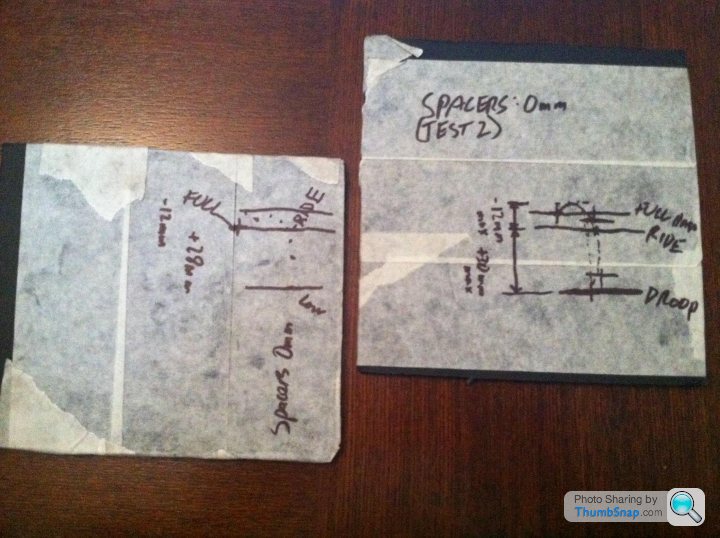
They both showed a bump oversteer of 1.2mm (actual measurement is divided by factor of 10) and a droop from ride height understeer/toeout of 3mm.
My modification of +2 and +4mm spacers under the rack:
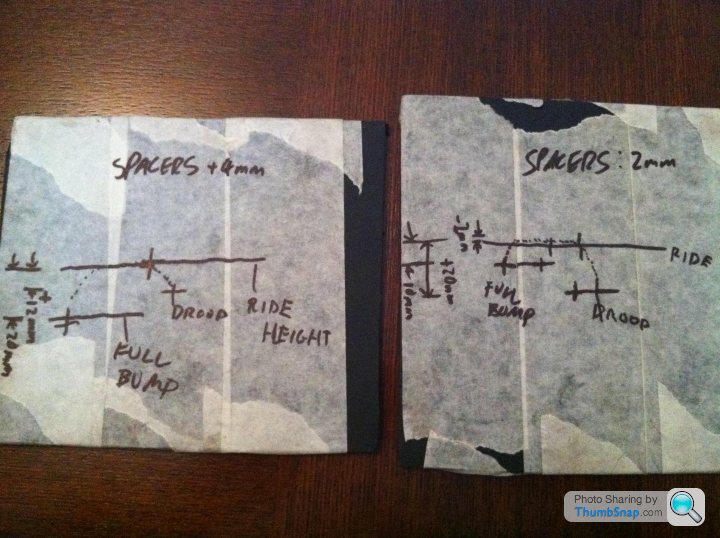
These showed 0mm to 0.2mm of bump oversteer for most of the travel and both showed toe out at the extremes of travel in bump and droop.
My conclusion is that 2mm seems to be the best compromise for my suspension set up.
I would be happier if that at full bump and full suspension droop, that there was less under steer/toeing out of the wheels, but in the grand scheme of things the suspension will spend very little time at those extremes.
As a result, I think I'll stick with the standard suspension components and add 2mm to the rack to raise it upwards. If I can measure the scrub radius and it falls significantly outside the centre line of the wheel, I'll have to consider adding some spacers as before. If that doesn't work, then parhaps the new arms might then make sense? Its not a cheap mod, but it would be worth it for a stable and predicatble cornering car.
I hope this was useful. Please let me know if you have any comments or dissagre with my method and findings. I want to get my car right now, whilst its easy to work on, so if you've had any experience with getting your Tuscan to handle correctly, I'm all ears!
Cheers,
Martin
For anyone wanting to know more about suspension design, I would reccoment reading "The sports car and Kit car suspension and brakes high performance manual". Its hardcore reading and takes a while to sink in. I'd also reccomend getting your hands on a remote controlled buggy so that you can play with the suspension and see the relationships and effects of different settings.
I am in the throws of rebuilding my Tuscan from the ground up:
http://www.pistonheads.com/gassing/topic.asp?h=0&a...
and the latest discussion has moved onto the suspension and whether I should change the design to the later configuration.
The research I have done shows that in march 2001 the design of the front suspension changed in the following way:
- The top wishbones were made longer/wider (pushing the ball joint outboard)

- The upright's top ball joint was moved outboards by circa 10mm
- A couple of different racks were used. The early (dates unknown) Tuscans used the same racks at the Chims, Griffs and the Cerbera V8 cars. (If anyone has more information on the specifics, please let me know).
- There are 2 track rod lengths quoted: 336mm (early cars, dates unknown) and 316mm (late Tuscans/T350 and Tamora).
- The King Pin Inclination was reduced.
- The longer wishbones reduced the dynamic effect on camber (leaning over of the wheel to maintain a square relationship to the road)
- The Scrub/Pivot radius was affected (assumed to have brought it inboard).
Bump steer is often refered to as "The problem with the early cars". From my dealings and involvement with the SP Wheel Spacers (I was the first person to test it), I understand that tyre wall height has an effect on the scrub radius and by either increasing the tyre wall or increasing your offset with a spacer, it is possible to alter the scrub radius.
From what I have read, the scrub radius needs to pass through the contact patch of the tyre and depending on whether it passes inboard or outboard of the centre line of the wheel, it can have an effect of pulling the wheel either outboard or inboard.
Acknowledging the above, if in addition to the scrub radius, there is an effect of bump steer that will cause the wheels to point outwards (positive toe) or inwards (negative toe), the effect can be significantly amplified.
Therefore, I set out to understand suspensions characteristics on MY CAR (Jan 2000). I can only comment on my car due to the aformentioned variables.
I set up my geometry to the following default factory settings:
- -0.7 degrees of negative (Camber)
- Shims either side of the upper ball joint (Castor)
- 1mm of front Toe in
I used this experimental setup/technique to measure bump steer: http://youtu.be/LO07qmJ9zkk
My videos show the standard setup, and with 4mm added beneath the steering rack.
http://youtu.be/3QKvdZWyV_I
http://youtu.be/_Yt0JcNhxOA
From what I understand, the thing to look out for is not to have too much bump oversteer. When there is compression of the outer wheel's suspension in a corner, any bump oversteer (additinal toe in) of the outer wheel, causes the wheel to point into the corner more than you want to/have dialed in with the steering wheel. If this happens you'll be turning in too much, so you'lll have to take off steering lock, which reduces the load on the outer wheel, (reducing the compression), which in turn takes off the bump oversteer, which then means you're not turning in enough, so you have to turn into the corner more...... This leads to an unstable cornering car that for want of a better word, 'weaves' through the corner.
The ideal scenario, is to not have any bump oversteer on the outside wheel, so that the amount you steer in, is the amount you get. Having said that, having bump understeer on the inside wheel, (which is drooping/lower than ride height due to body roll), means the inside wheel turns in more to the corner, which helps/can be beneficial up to a point.
I also tried the experiment with 2mm spacer. This seemed to give the best compromise. The suspension's toe stayed within 0.2mm thoughout 85% of the total travel of the suspension.
Here are the lazer traces:
I did 2 experiments at normal factory settings, one and the begining of the test and one at the end, after the 2mm and 4mm tests. (to validate consistency in my set up)
Factory setup:

They both showed a bump oversteer of 1.2mm (actual measurement is divided by factor of 10) and a droop from ride height understeer/toeout of 3mm.
My modification of +2 and +4mm spacers under the rack:

These showed 0mm to 0.2mm of bump oversteer for most of the travel and both showed toe out at the extremes of travel in bump and droop.
My conclusion is that 2mm seems to be the best compromise for my suspension set up.
I would be happier if that at full bump and full suspension droop, that there was less under steer/toeing out of the wheels, but in the grand scheme of things the suspension will spend very little time at those extremes.
As a result, I think I'll stick with the standard suspension components and add 2mm to the rack to raise it upwards. If I can measure the scrub radius and it falls significantly outside the centre line of the wheel, I'll have to consider adding some spacers as before. If that doesn't work, then parhaps the new arms might then make sense? Its not a cheap mod, but it would be worth it for a stable and predicatble cornering car.
I hope this was useful. Please let me know if you have any comments or dissagre with my method and findings. I want to get my car right now, whilst its easy to work on, so if you've had any experience with getting your Tuscan to handle correctly, I'm all ears!
Cheers,
Martin
blueg33 said:
Great Martin. That is very useful.
My car is a December 2000, I may start with raising the rack 2mm as you have.
What geo settings have you used after raising the rack?
I'm no expert and the car is still being built. I'd start with the standard settings and work from there.My car is a December 2000, I may start with raising the rack 2mm as you have.
What geo settings have you used after raising the rack?
If the rack was changed in '01 at the same time as the wishbones and the top ball joint, it sounds like it could be an expensive upgrade!!
Ken Barlow said:
when did the Tuscan go from 1.7 to 2 turns lock to lock
does this make then less skitish
The increase lock was possible by the top arms being changed slightly, allowing more lock. The rack remained the same but some of the nylon bump stops that prevented the wheels moving to much and clashing with upper wishbone were removed to give the extra throw/steering lock.does this make then less skitish
yzf1070 said:
I am however, intriuged by the authors intent on experimentations... Is the car being set up for track days, or racing?
My aim from all of this is to learn about suspension geometry and to dispel/validate the myths about Tuscan cornering and stability over bumps. As I mentioned before, I was the first to try the 3mm spacers from Silverstone Performance on my 04 Tuscan. Prior to fitting the spacers it was a pig to drive over rough stuff. The car had 7500miles from new and had been checked and set up at TVR Power. To all intents and purposes it was new and as the factory intended. Post spacers its was SO much better. There's a road with dips and bumps on the curb side near my house that throws most cars around as you ride over them. The Tuscan used to be the worst of the cars I owned, in terms of handling as it went over these bumps. Post 3mm spacers it was the best and I could hold onto the wheel with my finger and thumb (perviously had to use firm grip and white knuckles!).Having learnt that my current Cat D car was built in Jan '00 (very early car) and that there were differences between the geo implemented over time, I was keen to understand what changes TVR made and when they occured. Due to all the whispers and hearsay, I decided the best way to know for sure what was happening, was to do as scientific an experiment as possible use new parts and write it up as an experimental report for TVR enthusiasts to digest and comment on. This thread is the result of that work.
I'm now at a cross roads where I cold change all the bits for post 2002 parts it becuase it is just at rolling chassis at the moment. However, the bump steer traces show minor 1mm deflection in the middle 80% of travel, so to me that looks OK. Time and money is also against me. I want to make progress, not go backwards in the rebuild. I am also curios to experience the current set up. So I'm going to leave it as is, drive it on the road and track and then consider what changes to make next winter.
spitfire4v8 said:
hmm can't remember. I did refine a kit that a guy at a previous garage i worked at had done but he got it wrong so I fixed it for him. however that was a rack extender and rack raise shim kit. I wasn't convinced of it anyway, just i was asked to sort it out so I did. I think they made something like 20 kits made and sold 2 which probably tells you all you need to know.
Interesting! Widening/extending and rasing the rack is what TVR did in 2001, but they also moved the top ball joint outwards to reduce KPI.So by moving the steering rack ball joint out was to address the fact that the rack's/rod's inner ball joint did not align with the line between the upper and lower wishbone's chassis pick up points?
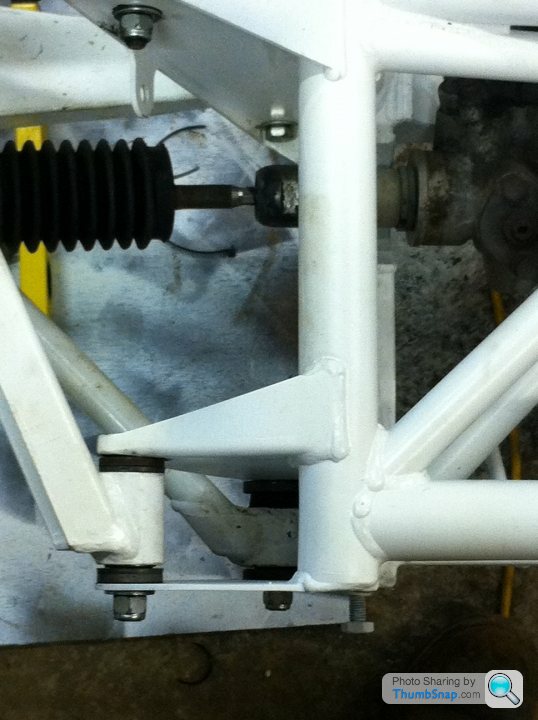
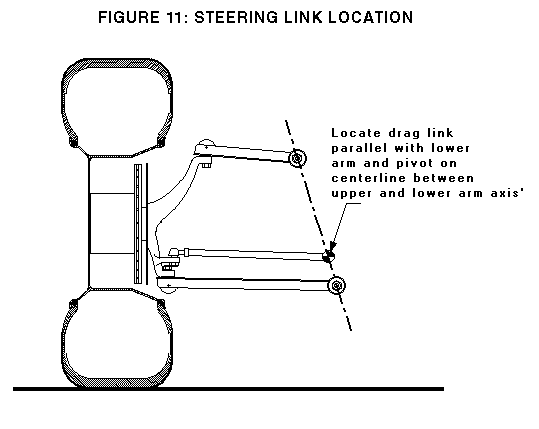
Edited by MPETT on Tuesday 7th February 10:40
Basil Brush said:
Just watched your bump steer measurement vids Martin and it's interesting to see the rate that it goes into toe-out on droop. It looks as though each wheel could have 1" bump toe-in anywhere between 1mm and 3.5mm depending what ride height it was set at. May partly explain why fitting Nitrons etc with a slightly lowered ride height gives such an improvement.
How did you define ride height?
Hi mr Brush,How did you define ride height?
I'm not sure where you've got 1" from??
 . My take on the results was that for 80% of the travel, the most used range of travel, the toe out and in was acceptable (with an extra 2-4mm of rack spacing.) Toe in was minimal (less than 1mm) in the middle 80% of travel) with toe out mainly at the extremes of bump and droop. The interesting results were when I did the test with 10-15degs of steering lock. In this instance at the top end of the compression/bump, the toe out was pretty extreme (5mm).
. My take on the results was that for 80% of the travel, the most used range of travel, the toe out and in was acceptable (with an extra 2-4mm of rack spacing.) Toe in was minimal (less than 1mm) in the middle 80% of travel) with toe out mainly at the extremes of bump and droop. The interesting results were when I did the test with 10-15degs of steering lock. In this instance at the top end of the compression/bump, the toe out was pretty extreme (5mm). So... I have concluded, that for my set up on my early car, that I need a firmIsh shock setting with an anti roll bar that limits travel at the extremes of bump and under heavy cornering. Im thinking the standard anti roll bar will do the trick?
This ties into the established general knowledge for Tuscan handling, that a replacement of the shocks with firmer shock settings along with the correct profile tyre helps to create a less twitchy car.
I'll be trying the spacers as well as there seems to be some positive feedback on the early cars that have used the spacers. I'll report back when I get the car on the road. Hopefully before the end of the summer.
Martin
Hi Marcus, I get what your saying and think that makes sense.
My set up to determin the ride height was to ensure the bottom wishbone mount and bottom upright ball joint were level.
In my case I'm definitely going to benefit from the rack being raised a little. To me the standard set up trace is not acceptable.
My set up to determin the ride height was to ensure the bottom wishbone mount and bottom upright ball joint were level.
In my case I'm definitely going to benefit from the rack being raised a little. To me the standard set up trace is not acceptable.
I had TVR Power check/set up my geo and they couldn't get the camber within spec, so I've had to enlarge the holes in the upper wishbones. I've increased the slots by 3.5mm which should give more camber adjustment. The current camber setting is +1.8degrees (leaning in) which makes the front end unstable over rough roads. Hopefully a camber setting closer to 0.5-1degrees will be better!
Edited by MPETT on Monday 17th March 22:38
So went out on a drive this morning down to silverstone for the Sunday service. What weather! I'm pleased to report that the suspension is now much much better than it was before. I've managed to firm up the shocks so that it now stops undulating over the bumps and feels properly under control. It was a few years ago that I had an 04 tuscan with spacers, but it doesn't feel bad to me right now at all!
Can anyone comment about when the early suspensions felt bad. Was it all the time, did it tram line a little bit or was it just when pushing hard? I was thinking about doing an airfield day to play around with the suspensions settings to see what works best.
Can anyone comment about when the early suspensions felt bad. Was it all the time, did it tram line a little bit or was it just when pushing hard? I was thinking about doing an airfield day to play around with the suspensions settings to see what works best.
We could go on for ages taking about this topic with no real conclusions! My car with the standard set up is now on the road and feels ok to me. As I get familiar with it, I will push it more, but the engine needs running in and so I'm not going bonkers.
Looking at the comments about the suspension behaviours, it appears obvious that people who've posted about their car's driving charteristics, they have a similar situation to the graphs/traces I recorded. High speed instability I think is more down to aero causing the front to lift, which in turn causes the suspension to sag and point the wheels outwards. The overtaking and B road instability is a simple fact the the steering arm is not matched to the geo of the wishbones. This can be minimised as I have done, by adding spacers below the rack, but one can not get away from the differential between these critical components and where the pivot on the chassis (pivot points in line, upper, lower and track rod inner ball joint).
To achieve this alignment a spacer can be fabricated and the use of shorter track rod arms could be used. Ill try this next.
The next step will be to go to the later setup with the longer upper wishbones and moving the upright upper ball joint outboard. (This requires my father to make use of his new hobby lathes nod pillar drill). This all takes time and money.
As I said, I'm happy with the way it drives for now.
I was wondering if perhaps those people that have discussed the options and experiences on here would like to meet up at Burleigh house and have a sharing of experiences and things they've tried? I'd be happy to coordinate a time and location and bring along a whiteboard
Looking at the comments about the suspension behaviours, it appears obvious that people who've posted about their car's driving charteristics, they have a similar situation to the graphs/traces I recorded. High speed instability I think is more down to aero causing the front to lift, which in turn causes the suspension to sag and point the wheels outwards. The overtaking and B road instability is a simple fact the the steering arm is not matched to the geo of the wishbones. This can be minimised as I have done, by adding spacers below the rack, but one can not get away from the differential between these critical components and where the pivot on the chassis (pivot points in line, upper, lower and track rod inner ball joint).
To achieve this alignment a spacer can be fabricated and the use of shorter track rod arms could be used. Ill try this next.
The next step will be to go to the later setup with the longer upper wishbones and moving the upright upper ball joint outboard. (This requires my father to make use of his new hobby lathes nod pillar drill). This all takes time and money.
As I said, I'm happy with the way it drives for now.
I was wondering if perhaps those people that have discussed the options and experiences on here would like to meet up at Burleigh house and have a sharing of experiences and things they've tried? I'd be happy to coordinate a time and location and bring along a whiteboard

Edited by MPETT on Tuesday 18th March 23:20
900T-R said:
In the tech specs the Tuscan seems to have a narrower front and rear track than the Griffith/Chimaera/Cerbera though...
According to web....Cerbera 4.2: Front track 1464 mm, Rear track 1470 mm.
Tuscan 4.0: Front track: 1445 mm, Rear track: 1500 mm.
As measured on my 2000 car...
Tuscan front: 1680mm and rear was 1700mm
measured from rim edge to rim edge)Not sure how else I could measure it to make it tie in with the figures on the web?
p.s. I've got the 3mm spacers either side, so I should take off 6mm from the front track.
Edited by MPETT on Wednesday 19th March 19:35
Right then. I've been around the cars at TVR Power to measure the overall width of a Tuscans and Cerberas using Spider wheels and the results (measured from what I can best judge as being the outside edge of the rim) are as follows:
My 2000 Tuscan:
Front: 1680mm, Rear: 1700mm
Cerbera Speed 6:
Front: 1680, Rear 1680mm
I spoke with Powers and they confirmed the front geo is the same between the Tuscan and the Cerbera. I asked about upgrading to the later geo, upright, rack, tie rods etc, and his advice was don't bother. He responce was that Cerberas, early Tuscans and later T series cars can all be made to handle. I agree that the inner ball joint on the tie rod/rack is not right and to be perfect it should be pushed outwards, but the book I've been reading on sport car suspension and the chap at powers both said, a small amount toe out can be useful in hard/tight cornering. Most of the time you're pointing straight ahead, with minor steering input, and my 2mm rack spacer mod makes the wheels point in the right direction for all but full bump (beyond where the bump stop would allow) and full droop, which you only really going to get when you're airborne or on appalling road surfaces with ditches/pot holes etc... when you're not going to be giving it some.
After this discussion with Powers, I went and had my geo checked/adjusted at a garage using the Hunter alignment system. I had my geo tweeked slightly (my eye, a spirit level and some string wasn't far out!)to the following settings and it feels great.
(FYI: there are 60 Mins of arc in a degree)
Front:
Toe: +10mins of arc per wheel (toe in)
Camber: -45mins of arc per side (wheel top is leaning into the car)...= -0.75degs
Caster: 1 Shim on both sides.
Rear:
Toe: +30mins of arc per wheel (toe in)..1 degree overall
Camber: -1deg&30mins per side (wheel top is leaning into the car)...= -1.5degs
Powers said to set the front wheels dead ahead, but I feel, given the nature of the suspension movements I've measured and should the suspension go to full droop, this small amount of toe in should counteract it and prevent the suspension pulling one way or the other.
On the drive home, I have to say it felt great, stable and very much under control. Smooth roads were obviously great, but the bumpy b roads all around my area, did not unsettle the car and I felt more and more confidence growing in the car.
So, I feel happy. I don't feel tempted to go further with modifications for now and I believe that it is stable and can be driven enthusiastically.
Of course I will go on evaluating the set up and report back with any new information that may be of use to the PH community and I plan to do some track days. Unfortunatley, 2nd gear is popping out so the next job is getting that fixed. I've seen positive things about Redman Racing.
Cheers,
Martin
My 2000 Tuscan:
Front: 1680mm, Rear: 1700mm
Cerbera Speed 6:
Front: 1680, Rear 1680mm
I spoke with Powers and they confirmed the front geo is the same between the Tuscan and the Cerbera. I asked about upgrading to the later geo, upright, rack, tie rods etc, and his advice was don't bother. He responce was that Cerberas, early Tuscans and later T series cars can all be made to handle. I agree that the inner ball joint on the tie rod/rack is not right and to be perfect it should be pushed outwards, but the book I've been reading on sport car suspension and the chap at powers both said, a small amount toe out can be useful in hard/tight cornering. Most of the time you're pointing straight ahead, with minor steering input, and my 2mm rack spacer mod makes the wheels point in the right direction for all but full bump (beyond where the bump stop would allow) and full droop, which you only really going to get when you're airborne or on appalling road surfaces with ditches/pot holes etc... when you're not going to be giving it some.
After this discussion with Powers, I went and had my geo checked/adjusted at a garage using the Hunter alignment system. I had my geo tweeked slightly (my eye, a spirit level and some string wasn't far out!)to the following settings and it feels great.
(FYI: there are 60 Mins of arc in a degree)
Front:
Toe: +10mins of arc per wheel (toe in)
Camber: -45mins of arc per side (wheel top is leaning into the car)...= -0.75degs
Caster: 1 Shim on both sides.
Rear:
Toe: +30mins of arc per wheel (toe in)..1 degree overall
Camber: -1deg&30mins per side (wheel top is leaning into the car)...= -1.5degs
Powers said to set the front wheels dead ahead, but I feel, given the nature of the suspension movements I've measured and should the suspension go to full droop, this small amount of toe in should counteract it and prevent the suspension pulling one way or the other.
On the drive home, I have to say it felt great, stable and very much under control. Smooth roads were obviously great, but the bumpy b roads all around my area, did not unsettle the car and I felt more and more confidence growing in the car.
So, I feel happy. I don't feel tempted to go further with modifications for now and I believe that it is stable and can be driven enthusiastically.
Of course I will go on evaluating the set up and report back with any new information that may be of use to the PH community and I plan to do some track days. Unfortunatley, 2nd gear is popping out so the next job is getting that fixed. I've seen positive things about Redman Racing.
Cheers,
Martin
Gassing Station | Tuscan | Top of Page | What's New | My Stuff




